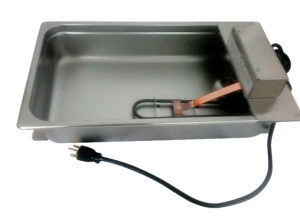High humidity levels are the biggest problem for open-air refrigeration systems. Even small amounts of moisture can hurt cold storage areas. This happens through condensation, slip hazards, and coil freezing.
Moisture buildup causes more serious problems in cold storage than in dry storage. This is because cold storage buildings are sealed tightly.
Understanding Humidity and Condensation
Humidity and condensation are key to how commercial refrigeration works. Humidity means the amount of moisture in the air. In refrigeration, this moisture exists as water vapor.
The amount of water vapor that air can hold depends on temperature. Hot air holds much more moisture than cold air.
Relative humidity (RH) is an important term. It shows the ratio of water in the air compared to how much it could hold at a given temperature.
When humid air touches colder surfaces inside a refrigerator, condensation forms. Water vapor in the air changes into liquid water. This phase change happens because of temperature and pressure changes.
The dew point is the temperature at which air reaches 100 percent RH. Condensation will form if air touches a surface at or below this temperature.
The temperature inside refrigeration units is lower than the dew point of the surrounding air. This means condensation will always form. If not managed properly, this leads to frost formation. Moisture in the air condenses and freezes on cooling coils.
Negative Effects of High Humidity
High humidity and condensation seriously harm commercial refrigeration units. They affect efficiency, lifespan, and the quality of stored products. Key problems include:
Reduced Efficiency and Higher Energy Use
High humidity causes ice buildup on cooling coils. This makes them less effective at absorbing heat. The compressor must work harder and longer to maintain the right temperature. This leads to higher energy use and more wear on components.
Excess moisture in the system also reduces heat transfer efficiency. It affects the refrigerant’s properties.
Component Damage and System Failure
Moisture combines with refrigerants and lubricants to form acids. These acids corrode metal parts like pipes, coils, and compressors. This leads to leaks and component failure.
Condensation can freeze refrigerant lines. This causes mechanical damage. It can also get into electrical components and cause short circuits and malfunctions.
Impact on Product Quality
High humidity encourages mold, mildew, and bacterial growth. These can spoil food and make it unsafe to eat. High humidity also causes freezer burn and packaging damage. It creates condensation on glass doors that blocks visibility.
Methods for Controlling Humidity in Commercial Units
The most common method for reducing humidity is letting coils freeze, then defrosting them to remove water. This method has major disadvantages. These include higher energy consumption, wear on the refrigeration units, and temperature spikes.
More effective methods include:
- Conducting regular maintenance
- Ensuring proper sealing by checking gaskets and seals
- Installing a dehumidifier or using desiccants
- Monitoring and maintaining optimal temperature and defrost cycles
- Leveling the unit and checking for adequate air clearances
Additional Ways to Control Humidity
A dehumidifier is an ideal way to fight humidity in freezers and cold chain units. It should be used with other proven methods. For example, rapid doors, vapor barriers, vinyl curtains, and air curtains help limit moisture invasion.
Using forced air circulation and fin and tube evaporators are effective methods for managing condensation. They work better than static cooling systems.
How Dehumidifiers Work to Control Moisture
In simple terms, desiccant dehumidifiers absorb water molecules from the air into a desiccant wheel. A second heated air stream removes water from the desiccant wheel. It sends the water outside the building as vapor.
This process can improve air quality inside refrigeration or cold chain units. It prevents the harmful effects of high relative humidity.
You can add a dehumidifier to an existing cold chain unit. It works with the unit’s refrigeration system. Desiccant dehumidifiers are a good investment if you need complete environmental control in your cold chain application.
Final Words
When refrigerated display cases or commercial refrigeration units operate in a store environment, they exchange heat and moisture with the store air. Methods have been developed that assess how relative humidity affects the energy performance of refrigerated display cases.
Understanding and controlling humidity is essential for efficient refrigeration operation. Proper humidity control protects equipment, saves energy, and maintains product quality.



